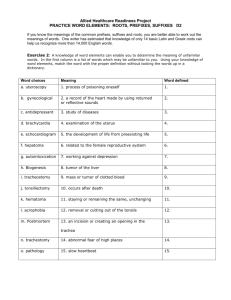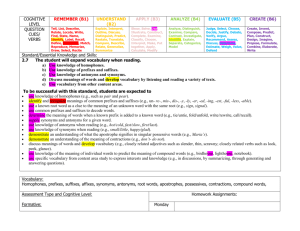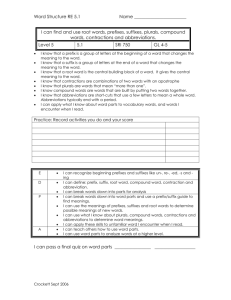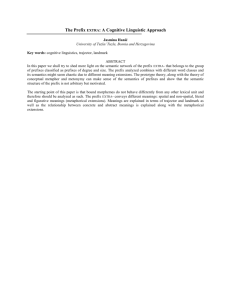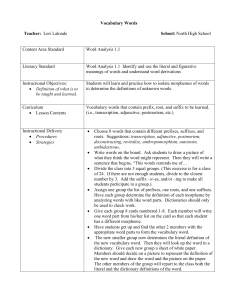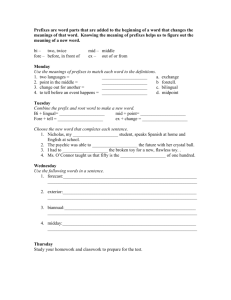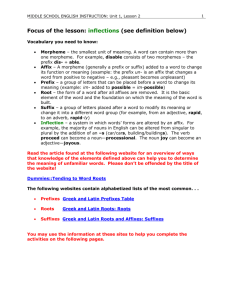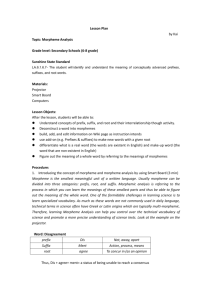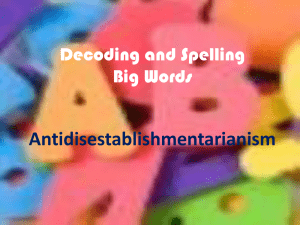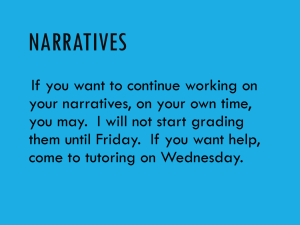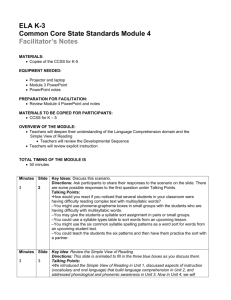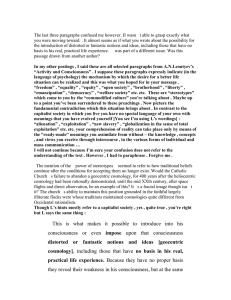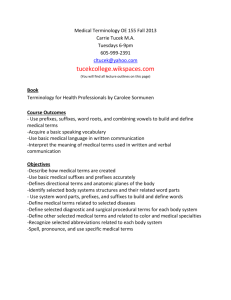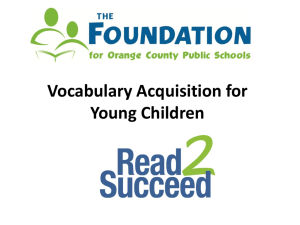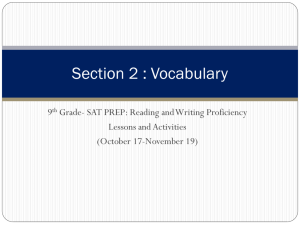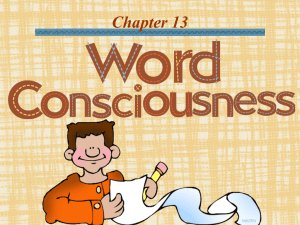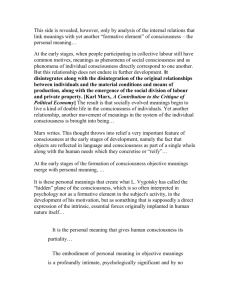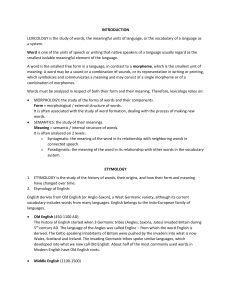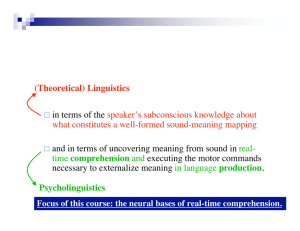Vocabulary Support for all learners
advertisement
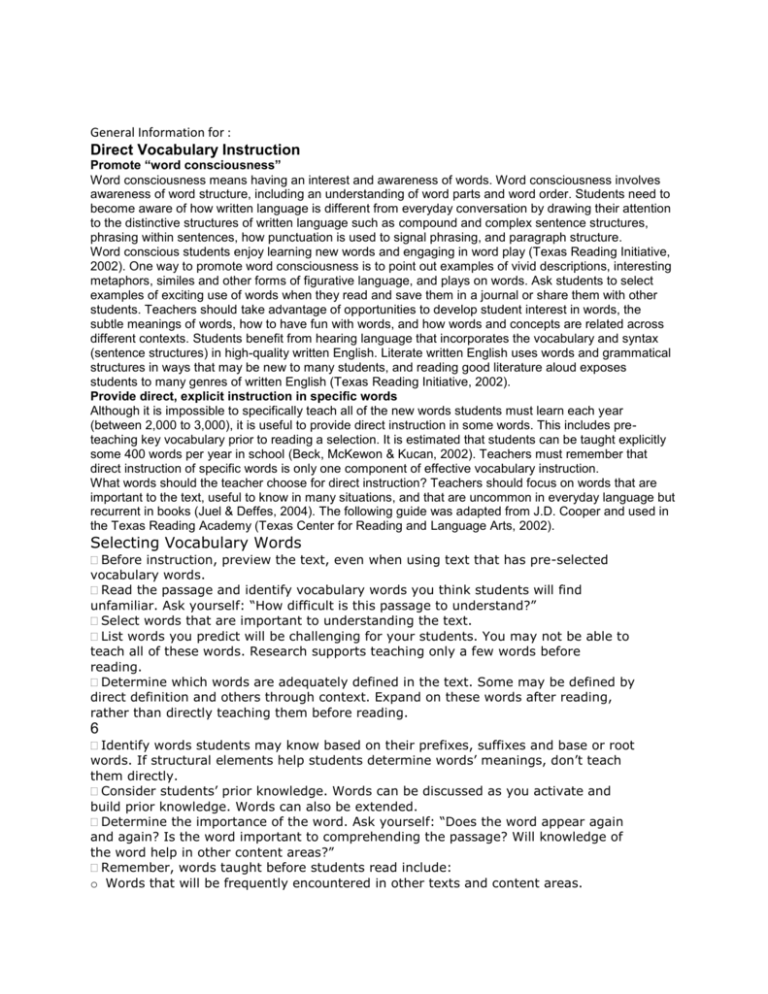
General Information for : Direct Vocabulary Instruction Promote “word consciousness” Word consciousness means having an interest and awareness of words. Word consciousness involves awareness of word structure, including an understanding of word parts and word order. Students need to become aware of how written language is different from everyday conversation by drawing their attention to the distinctive structures of written language such as compound and complex sentence structures, phrasing within sentences, how punctuation is used to signal phrasing, and paragraph structure. Word conscious students enjoy learning new words and engaging in word play (Texas Reading Initiative, 2002). One way to promote word consciousness is to point out examples of vivid descriptions, interesting metaphors, similes and other forms of figurative language, and plays on words. Ask students to select examples of exciting use of words when they read and save them in a journal or share them with other students. Teachers should take advantage of opportunities to develop student interest in words, the subtle meanings of words, how to have fun with words, and how words and concepts are related across different contexts. Students benefit from hearing language that incorporates the vocabulary and syntax (sentence structures) in high-quality written English. Literate written English uses words and grammatical structures in ways that may be new to many students, and reading good literature aloud exposes students to many genres of written English (Texas Reading Initiative, 2002). Provide direct, explicit instruction in specific words Although it is impossible to specifically teach all of the new words students must learn each year (between 2,000 to 3,000), it is useful to provide direct instruction in some words. This includes preteaching key vocabulary prior to reading a selection. It is estimated that students can be taught explicitly some 400 words per year in school (Beck, McKewon & Kucan, 2002). Teachers must remember that direct instruction of specific words is only one component of effective vocabulary instruction. What words should the teacher choose for direct instruction? Teachers should focus on words that are important to the text, useful to know in many situations, and that are uncommon in everyday language but recurrent in books (Juel & Deffes, 2004). The following guide was adapted from J.D. Cooper and used in the Texas Reading Academy (Texas Center for Reading and Language Arts, 2002). Selecting Vocabulary Words Before instruction, preview the text, even when using text that has pre-selected vocabulary words. Read the passage and identify vocabulary words you think students will find unfamiliar. Ask yourself: “How difficult is this passage to understand?” Select words that are important to understanding the text. List words you predict will be challenging for your students. You may not be able to teach all of these words. Research supports teaching only a few words before reading. Determine which words are adequately defined in the text. Some may be defined by direct definition and others through context. Expand on these words after reading, rather than directly teaching them before reading. 6 Identify words students may know based on their prefixes, suffixes and base or root words. If structural elements help students determine words’ meanings, don’t teach them directly. Consider students’ prior knowledge. Words can be discussed as you activate and build prior knowledge. Words can also be extended. Determine the importance of the word. Ask yourself: “Does the word appear again and again? Is the word important to comprehending the passage? Will knowledge of the word help in other content areas?” Remember, words taught before students read include: o Words that will be frequently encountered in other texts and content areas. o Words that are important to understanding the main ideas. o Words that are not a part of your student’ prior knowledge. o Words unlikely to be learned independently through the use of context and/or structural analysis. Adapted from Cooper, J.D. (1997). Literacy: Helping children construct meaning (3rd ed.). Boston: Houghton Mifflin. ______________________________________________________________________ __ Once specific words are chosen, the vocabulary instruction must be analytical and substantial for words to “really stick” (Juel & Deffes, 2004). Teachers must provide clear explanations and examples of the meanings of these words in various contexts, and provide students with opportunities to discuss, analyze, and use the words. Simply looking up a definition in a dictionary is not enough. Have students rewrite definitions in their own words, provide examples of situations where the word could be used, supply synonyms (and antonyms when possible) and create sentences using the word that clearly show the meaning. Sometimes it is useful to have students use more than one new word in a single sentence because it forces them to look for relations among words (Stahl, 1999). This kind of direct vocabulary instruction is particularly important for students with learning disabilities (Juell & Deffes, 2004). Direct instruction of specific words can include teaching the multiple meanings of some words, different word associations (such as antonyms and synonyms), and word concepts (such as related concept words and categories of words). Analyzing word structure: Teaching word parts When students encounter unknown words they can use knowledge of word parts (root words, suffixes and prefixes) to help determine the meaning. This is especially true when reading content textbooks because these texts often contain many words that are derived from the same word parts. For example, the Greek root “bio” (meaning “life, living organisms”) reappears again and again in a typical middle school life science textbook (e.g., biology, biologist, biosphere, biodegradable, biochemical, biofuel, biohazard). Another example is the prefix “mono” (meaning “one, alone, single”). If students are familiar with the meaning of the prefix mono, the prefix “poly” (meaning “many”), and the base word “theism” (meaning “belief in the existence of a god or gods”), they can determine that the difference between “monotheism” and “polytheism” is the difference between believing in only one god or many gods. Structural analysis of a word draws the student’s attention to the individual units of meaning in the word, also known as morphemes. A free morpheme, or root word, can stand alone (e.g., cut), while a bound morpheme needs to be attached to another morpheme (e.g., ing, un), and two free morphemes can combine to form a compound word (e.g., airplane) (Blachowicz & Fisher, 2004). In the beginning stages of reading, rapid and automatic word analysis is essential for developing decoding and fluency skills; at this level, the purpose of word analysis is to identify (sound out) the word. The focus of word analysis for vocabulary is on the meaningful parts of a word to help determine its overall meaning. Some students may not realize that they can use their knowledge about how to divide words into parts to figure out word meanings. There are numerous sources for lists of common root words and affixes (suffixes and prefixes).
